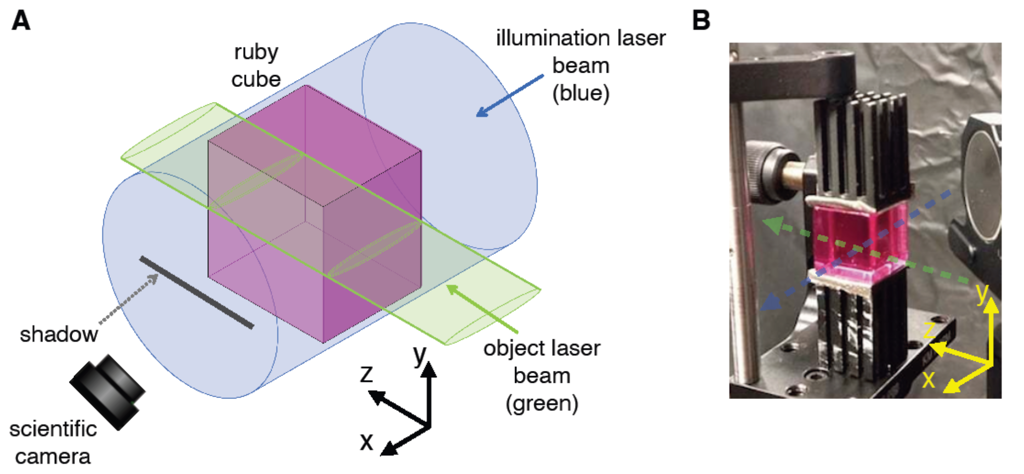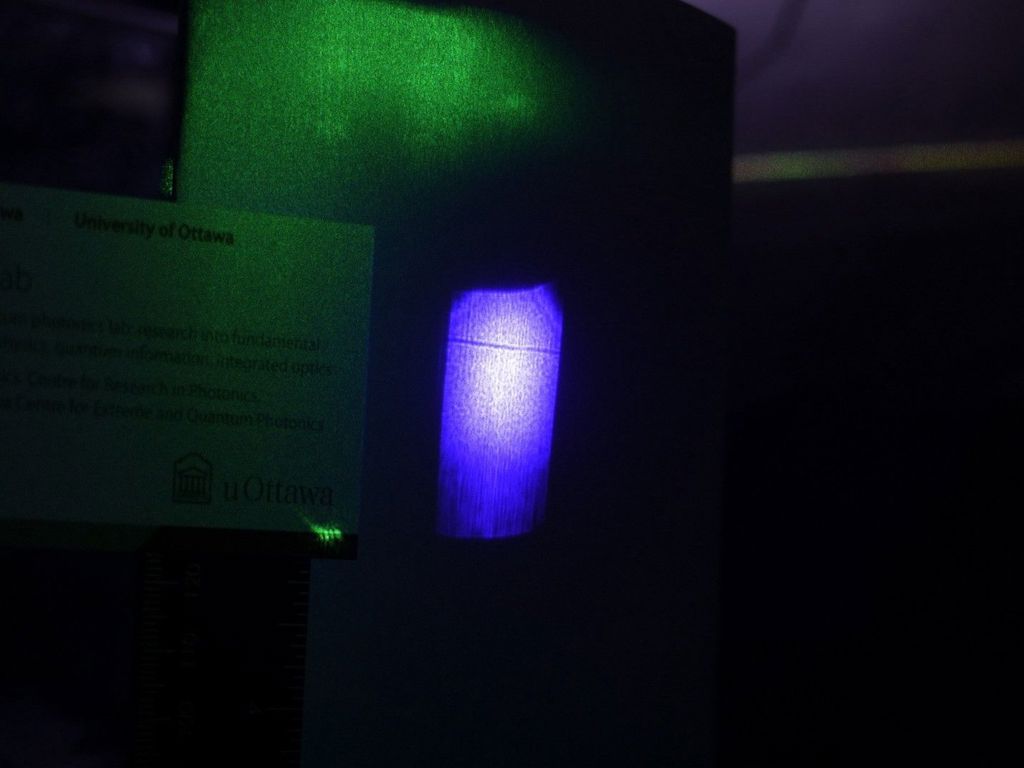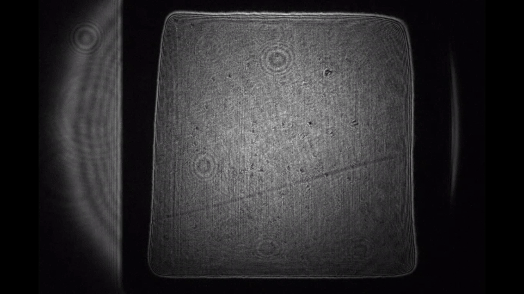Scientists discover laser light can cast a shadow
About Optica
14 November 2024
Scientists discover laser light can cast a shadow
Surprising finding could lead to new ways of controlling light
WASHINGTON — Can light itself cast a shadow? It may sound like a philosophical riddle, but researchers have found that under certain conditions, a laser beam can act like an opaque object and cast a shadow. The discovery challenges the traditional understanding of shadows and opens new possibilities for technologies that could use a laser beam to control another laser beam.

Caption: For the experiment, a high-power green laser was directed through ruby cube and illuminated with a blue laser from the side. The green laser increases the optical absorption of the blue illuminating laser beam, creating a matching region in the illuminating light and creating a darker area that appears as a shadow of the green laser beam.
Credit: Abrahao et al.
“Laser light casting a shadow was previously thought impossible since light usually passes through other light without interacting,” said research team leader Raphael A. Abrahao from Brookhaven National Laboratory, previously at the University of Ottawa. “Our demonstration of a very counter-intuitive optical effect invites us to reconsider our notion of shadow.”
In Optica, Optica Publishing Group’s journal for high-impact research, the researchers describe how they used a ruby crystal and specific laser wavelengths to show that a laser beam could block light and create a visible shadow due to a nonlinear optical process. This effect occurs when light interacts with a material in an intensity-dependent way and can influence another optical field.
“Our understanding of shadows has developed hand-in-hand with our understanding of light and optics,” said Abrahao. “This new finding could prove useful in various applications such as optical switching, devices in which light controls the presence of another light, or technologies that require precise control of light transmission, like high-power lasers."
Lunch talk sparks idea
The new research is part of a larger exploration into how a light beam interacts with another light beam under special conditions and nonlinear optical processes. The idea started over a lunch conversation when it was pointed out that some experimental schematics made with 3D visualization software depict the shadow of a laser beam because they treat it as a cylinder without accounting for the physics of a laser beam. Some of the scientists wondered: Could this be done in a lab?

Caption: Researchers showed that a laser beam can sometimes act like a solid object and cast a shadow that is visible to the naked eye. In the picture, the shadow appears as the horizontal line traversing the blue background.
Credit: Abrahao et al.
“What started as a funny discussion over lunch led to a conversation on the physics of lasers and the nonlinear optical response of materials,” said Abrahao. “From there, we decided to conduct an experiment to demonstrate the shadow of a laser beam.”
To do this, the researchers directed a high-power green laser through a cube made of standard ruby crystal and illuminated it with a blue laser from the side. When the green laser enters the ruby, it locally changes the material response to the blue wavelength. The green laser acts like an ordinary object while the blue laser acts like illumination.
The interaction between the two light sources created a shadow on a screen that was visible as a dark area where the green laser blocked the blue light. It met all the criteria for a shadow because it was visible to the naked eye, followed the contours of the surface it fell on and followed the position and shape of the laser beam, which acted as an object.
The laser shadow effect is a consequence of optical nonlinear absorption in the ruby. The effect occurs because the green laser increases the optical absorption of the blue illuminating laser beam, creating a matching region in the illuminating light with lower optical intensity. The result is a darker area that appears as a shadow of the green laser beam.
Shadow measurements
“This discovery expands our understanding of light-matter interactions and opens up new possibilities for utilizing light in ways we hadn’t considered before,” said Abrahao.
The researchers experimentally measured the dependence of the shadow's contrast on the laser beam's power, finding a maximum contrast of approximately 22%, similar to the contrast of a tree's shadow on a sunny day. They also developed a theoretical model and showed that it could accurately predict the shadow contrast.

The researchers say that from a technological perspective, the effect they demonstrated shows that the intensity of a transmitted laser beam can be controlled by applying another laser. Next, they plan to investigate other materials and other laser wavelengths that can produce similar effects.
Paper: R. A. Abrahao, H. P. N. Morin, J. T. R. Pagé, A. Safari, R. W. Boyd, J. S. Lundeen, “The shadow of a laser beam,” Optica, 11, 1549-1555 (2024).
DOI: 10.1364/OPTICA.534596.
About Optica Publishing Group
Optica Publishing Group is a division of the society, Optica, Advancing Optics and Photonics Worldwide. It publishes the largest collection of peer-reviewed and most-cited content in optics and photonics, including 18 prestigious journals, the society’s flagship member magazine, and papers and videos from more than 835 conferences. With over 400,000 journal articles, conference papers and videos to search, discover and access, our publications portfolio represents the full range of research in the field from around the globe.
About Optica
Optica is an open-access journal dedicated to the rapid dissemination of high-impact peer-reviewed research across the entire spectrum of optics and photonics. Published monthly by Optica Publishing Group, the Journal provides a forum for pioneering research to be swiftly accessed by the international community, whether that research is theoretical or experimental, fundamental or applied. Optica maintains a distinguished editorial board of more than 60 associate editors from around the world and is overseen by Editor-in-Chief Prem Kumar, Northwestern University, USA. For more information, visit Optica.
Aaron Cohen
(301) 633-6773
